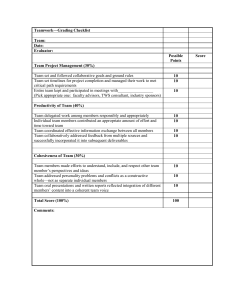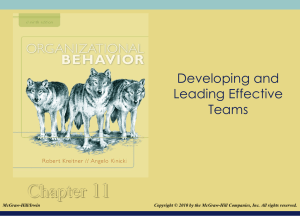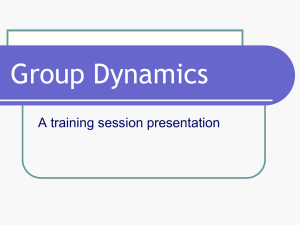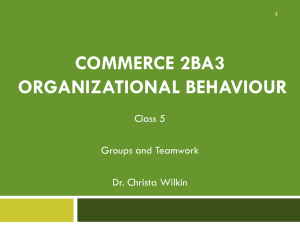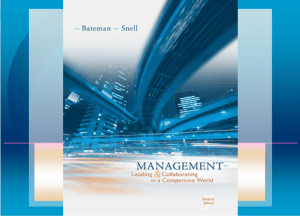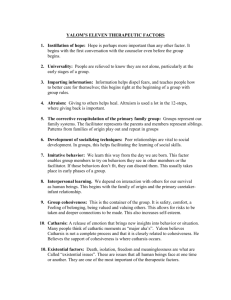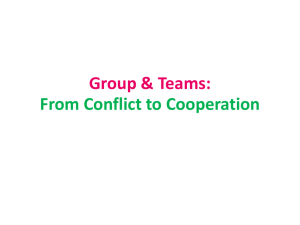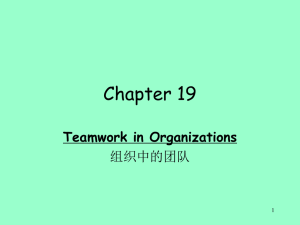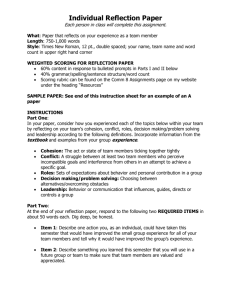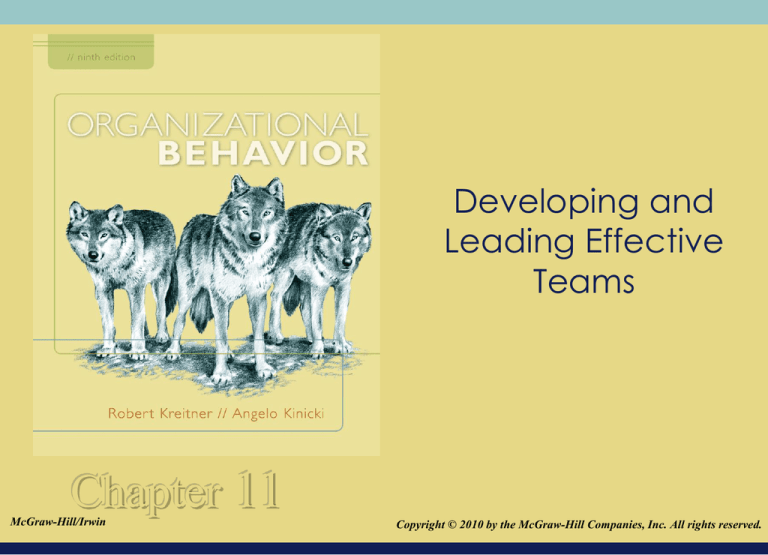
Developing and
Leading Effective
Teams
Chapter 11
McGraw-Hill/Irwin
Copyright © 2010 by the McGraw-Hill Companies, Inc. All rights reserved.
© 2008The McGraw-Hill Companies, Inc. All rights reserved.
Ch. 11 Learning Objectives
1. Explain how a work group becomes a team.
2. Identify and describe four types of work
teams.
3. Explain the model of effective work teams,
and specify the two criteria of team
effectiveness.
4. Identify five teamwork competencies team
members need to possess.
5. Discuss why teams fail.
11-2
Ch. 11 Learning Objectives
6. List at least four things managers can do to
build trust.
7. Distinguish two types of group cohesiveness,
and summarize cohesiveness research
findings.
8. Define virtual teams and self-managed teams
9. Describe high-performance teams and
discuss team leadership.
11-3
Teams
Team Small group with
complementary skills who
hold themselves mutually
accountable for common
purpose, goals, and
approach
11-4
Evolution of Teams
A Work Group Becomes a Team When:
1)
2)
3)
4)
5)
Leadership becomes a shared
activity
Accountability shifts from
strictly individual to both
individual and collective
The group develops its own
purpose or mission
Problem solving becomes a way
of life, not a part-time activity
Effectiveness is measured by
the group’s collective outcomes
and products
11-5
Teams
What are the
characteristics of a
successful basketball
team?
What parallels can
we make to work
teams?
11-6
Types of Work Teams
11-7
Effective Work Teams
11-8
Teamwork Competencies
Orients Team to
Problem-solving
Situation
Organizes and
Manages Team
Performance
Promotes a Positive
Team Environment
Facilitates and Manages
Task Conflict
Appropriately
Promotes Perspective
11-9
Characteristics of Effective Teamwork
11-10
Why Work Teams Fail
11-11
Effective Teamwork Requires:
Cooperation rather than
competition
• Within teams
• Among teams within
organizations
Trust reciprocal faith in
others’ intentions and
behavior
Cohesiveness a sense of
“we-ness”, strength of team
members’ desires to remain a
part of the team
11-12
Interpersonal Trust Involves a Cognitive Leap
Cognitive leap
Figure 11-3
Faith in the other person’s
good intentions
Assumption that other person
will behave as desired
Firsthand knowledge
of other person’s
reliability and
integrity
Distrust
Trust
What can you do to build trust?
11-13
Cohesiveness
A sense of “we-ness” helps
the group stick together
Socio-emotional
cohesiveness
• Sense of togetherness based
on emotional satisfaction
Instrumental cohesiveness
• Sense of togetherness based
on mutual dependency
needed to get the job done
11-14
Test Your Knowledge
Military units engaged in coordinated
efforts involving life or death situations
would most likely rely on
a. Socio-emotional cohesiveness
b. Instrumental cohesiveness
11-15
Enhancing Cohesiveness
11-16
Test Your Knowledge
1.
2.
3.
4.
5.
True (A) or False (B)
Too much team cohesiveness can be a
problem for the organization.
In general, success leads to cohesion, rather
than cohesion causing success
Smaller teams are more cohesive
External threats hurt team cohesiveness
Members of cohesive teams enjoy more
satisfaction and less turnover
11-17
Teams in Action: Basic Distinctions
11-18
How to Manage Virtual Teams
Establish regular times for group
interaction
Set up firm rules for
communication
Use visual forms of communication
where possible
Emulate the attributes of colocated teams
Give and receive feedback and
offer assistance on a regular basis
Agree on standard technology so
all team members can work
together easily
11-19
How to Manage Virtual Teams
Consider using 360-degree feedback to better
understand and evaluate team members
Provide a virtual meeting room via intranet,
web site, or bulletin board
Note which employees effectively use e-mail to
build team rapport
Smooth the way for an employee’s next
assignment if membership on the team, or the
team itself is not permanent
Be available to employees, but don’t wait for
them to seek you out
Encourage informal, off-line conversations
between team members
11-20
Test Your Knowledge
Joachim is the leader of a virtual team. Due to time zone
differences, the team has difficulty finding times to meet
but found a time for a conference call today. Aileen, a
fellow team member, was supposed to make a
presentation to the group but never dialed into the call.
In order to preserve the relationships among team
members, after the conference call Joachim should:
a. send an email to Aileen's boss regarding her absence
from the call.
b. complain to team members about Aileen's behavior.
c. call Aileen directly to inquire about her absence from
11-21
the call.
Ways to Empower Self-Managed Teams
11-22
Attributes of High Performance Teams
1) Participative
leadership
2) Shared responsibility
3) Aligned on purpose
4) High communication
5) Future focused
6) Focused on task
7) Creative talents
8) Rapid response
11-23
Self-Management Leadership Behaviors
1)
2)
3)
4)
5)
6)
Encourages selfreinforcement
Encourages selfobservation/evaluation
Encourages selfexpectations
Encourages self-goalsetting
Encourages rehearsal
Encourages self-criticism
11-24
Developing and
Leading Effective
Teams
Supplemental
Slides
Chapter 11
© 2008The McGraw-Hill Companies, Inc. All rights reserved.
Where is your trust?
Suppose you lend a friend a DVD to
watch on the agreement that he will
mail it back to Netflix. You find out
your friend forgot to return the movie
to the rental company. He apologizes
very sincerely and assures you it won’t
happen again.
How likely are you to trust him with
another DVD?
11-26
Where is your trust?
Now, assume you lent a DVD to
another friend and when you ask if she
sent it back to Netflix she says “Yes.”
Later you discover she lied when you
see the DVD on top of her TV. Your
friend apologizes and promises to
follow through next time.
How likely are you to trust this friend
with another DVD?
11-27
Recent Research on Trust
Schweitzer, Hershey, and Bradlow (2006) –
conducted laboratory study and found…..
•When trust is broken by untrustworthy actions,
it can be restored through consistent
trustworthy actions
•A promise to act in a trustworthy way helps
facilitate the regaining of trust
•Deception does serious long-term damage to
trust and makes it very difficult to restore, even
when followed by trustworthy actions
11-28
How to Build Trust
What can you do to build trust?
•
•
•
•
•
•
Communicate
Support
Respect
Fair
Predictable
Competent
11-29
Video Cases
Teamwork: Team Activities for Coworkers
11-30
Management in the Movies
Hoosiers – “And Two More”
In this scene, Coach Dale is meeting and practicing
with his team for the first time.
Questions
What type of leader is Coach Dale?
Is Coach Dale an effective leader?
How does he react to disagreement from his players?
11-31
Groups & Teams
Group - two or more
freely interacting
individuals, collective
norms, collective goals,
common identity
Team - Small group with
complementary skills who
hold themselves mutually
accountable for common
purpose, goals, and
approach
11-32
Groups Vs. Teams
Group
Goal
Synergy
Accountability
Skills
Team
Share information
Collective
performance
Neutral (sometimes
negative)
Positive
Individual
Individual and
mutual
Random and Varied Complementary
11-33
A Winning Team
Tennessee Volunteers win NCAA Women’s
Basketball Title – April 2007
How? In the off-season
• Good players recruited
• Junior Nicky Anosike developed “The Lady Vol Pact”
The Lady Vol Pact – January 2007
• Gained input from all team members
• Final draft contained 8 points everyone agreed to
• “I will give it my all on both sides of the court”
• “I‘ll take any advice given to me by teammates”
Source: Summitt, Vols on Top again, Patrick, D. USA Today 4/4/07 pp. 1C-2C
11-34
Panel Urges Focus on Teamwork
Employers
Recent Graduates
45
40
35
30
25
20
15
10
5
0
Teamwork
Critical Thinking
Oral/Written
Communication
11-35
Team Trust
Which of the following is true?
a. Trust among members is sufficient to ensure
successful teams.
b. Trust is really not that important when
working in a team.
c. Trust is only important when the team
members work autonomously on their teamrelated tasks.
d. Trust can reduce performance in teams when
team members operate autonomously.
11-36
Virtual Teams – Quotes from the Front
Line
“Since I don’t know those people in [other
cities], getting their stuff done is a low priority.
My priorities are about things that are in my
face, like when people I see every day are
standing there looking at me, waiting for me to
get their stuff done.”
“Everybody is so busy that you know they’re all
multitasking during the call. When I’m the one
leading a meeting, I’m pretty sure half of them
are checking their e-mails. Nobody pays much
11-37
attention.”
Virtual Teams – Quotes from the Front
Line
Example email: “Problem with the project
design. Let’s discuss at next week’s meeting –
Sam.”
Receiver’s reaction:
• I put a lot of time into that project design
• Who is Sam anyway?
• Should I trust his judgment?
11-38
Tips for Working on Virtual Teams
Meet face-to-face to start a project and for major
milestones
Assume positive intent
• If an e-mail's tone sounds off-putting, withhold
judgment until you learn more or talk to them directly
via phone
Engage in positive predictable behavior
• Honor commitments, attend meetings on time, don’t
send terse emails
11-39
Tips for Working on Virtual Teams
Respect.
• Ensure everyone feel they have a voice on the team.
Be in the moment.
• Pay attention to the meeting you are in – no cell phones,
checking e-mail, etc.
Contribution
• Everyone should be clear what they should do to
contribute to the team’s goals.
11-40
Which Teams are More Productive?
Small Teams
Big Teams
82%
16%
Decide by Consensus
One Strong Decision-Maker
81%
17%
People Differ from One Another
People are Similar to One
Another
48%
47%
11-41
Leaders Building Trust
To Build Trust, Leaders can:
Give people reasons to
trust one another instead
of reasons to watch their
backs
Refuse to reward
successes that are built
on untrusting behavior
Display trust and
trustworthiness in their
own actions; personally
and on company’s behalf
11-42
Building Trust in Traditional & Virtual
Teams
Nonwork-related communication
Reduction of task and technological uncertainty
Team members who demonstrate initiative
Team leaders who communicate in a predictable
manner
Timely and meaningful response to problems and
issues
Positive and enthusiastic leadership
Ability to shift focus from procedures to tasks
Crises handled as “business as usual”
11-43
Conclusion
Questions for discussion
11-44

